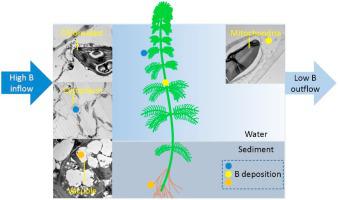Journal of Hazardous Materials ( IF 12.2 ) Pub Date : 2020-06-28 , DOI: 10.1016/j.jhazmat.2020.123333 Jingye Xia 1 , Tianwei Hua 1 , Yuan Xue 1 , Lejun Zhao 2 , Hongwen Sun 1 , Chunguang Liu 1

|
Phytoremediation is considered to be a cost-effective strategy for removing boron (B) from polluted water. In this study, Myriophyllum elatinoides, a widespread submerged or floating macrophyte, was found to survive in 40 mg B/L. Time-dependent kinetics show that the shoot exhibits a much longer period of B uptake and a much higher maximal tissue B concentration than the root. High values of the bioconcentration factor (BCF) and translocation factor (TF) indicate that M. elatinoides is a potential hyperaccumulator of B. Transmission electron micrographs show that excess B damages the cells of M. elatinoides, and the major target organelles are the chloroplast (leaf), mitochondria (stem and root), and nucleolus (root). Energy dispersive spectroscopy (EDS) shows that B is mainly deposited in the cytoplasm and on the surface of the chloroplast of the leaf cell. In the stem and root cells, B is mainly deposited on the mitochondrial membrane and in the vacuoles, respectively. This study indicates that the mechanisms of B toxicity, tolerance, and accumulation in M. elatinoides are involved in the cellular localization of B. Future work should focus on the evaluation of the physiological and genetic mechanisms involved in B tolerance and accumulation in M. elatinoides under different conditions.
中文翻译:

紫薇(Myriophyllum elatinoides):潜在的低硼污染水平植物水的植物修复方法。
植物修复被认为是从污水中去除硼(B)的一种经济有效的策略。在这项研究中,发现一种广泛存在于水中或漂浮的大型植物Myriophyllum elatinoides能够在40 mg B / L下存活。随时间变化的动力学结果表明,与根部相比,枝条的B吸收期更长,最大组织B浓度更高。生物富集因子(BCF)和易位因子(TF)的高值表明,埃拉美体杆菌是B的潜在超蓄积体。透射电子显微照片显示,过量的B会损害埃拉美体杆菌的细胞。,主要的靶细胞器是叶绿体(叶),线粒体(茎和根)和核仁(根)。能量色散光谱法(EDS)表明,B主要沉积在叶细胞的细胞质和叶绿体表面。在干细胞和根细胞中,B主要分别沉积在线粒体膜和液泡中。这项研究表明,E . Elatinoides的B毒性,耐受性和积累机制与B的细胞定位有关。今后的工作应集中在评估E. Elatinoides的B耐受性和积累中的生理和遗传机制。在不同条件下。









































 京公网安备 11010802027423号
京公网安备 11010802027423号